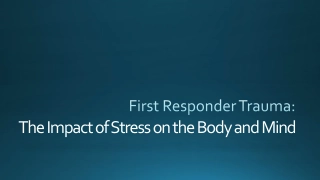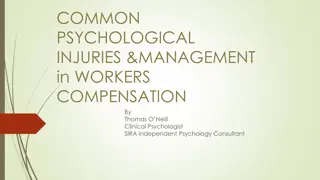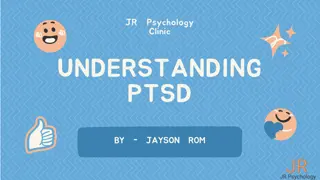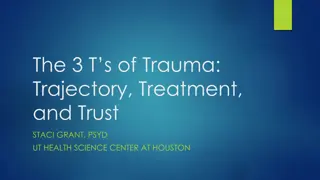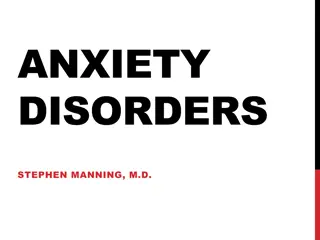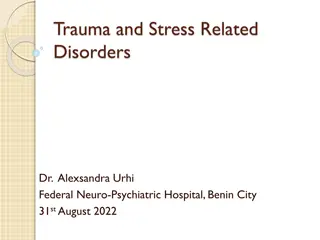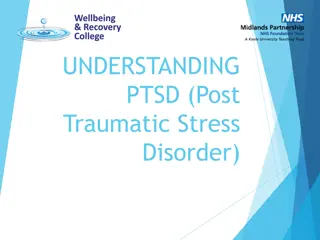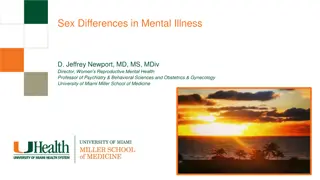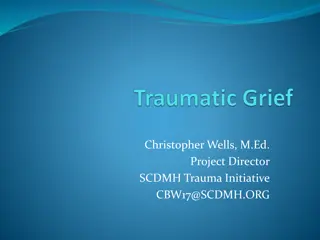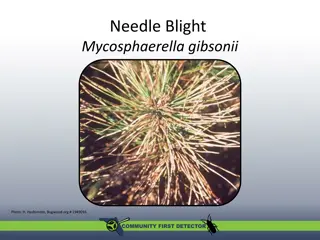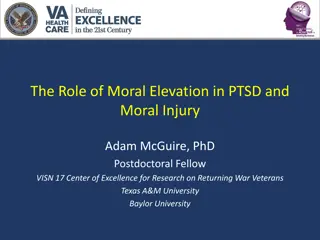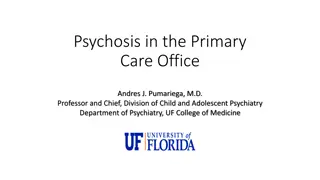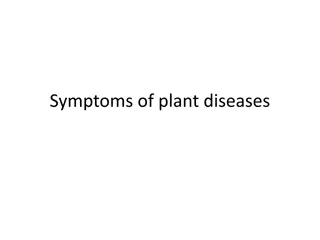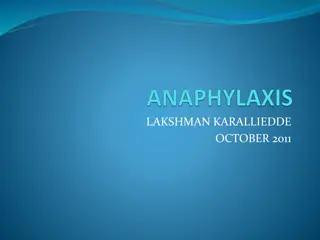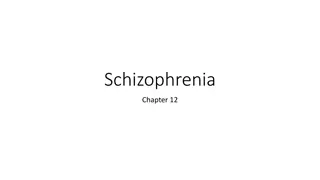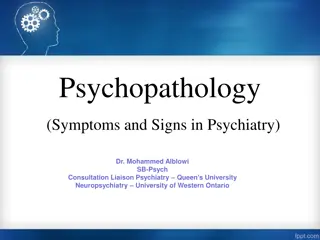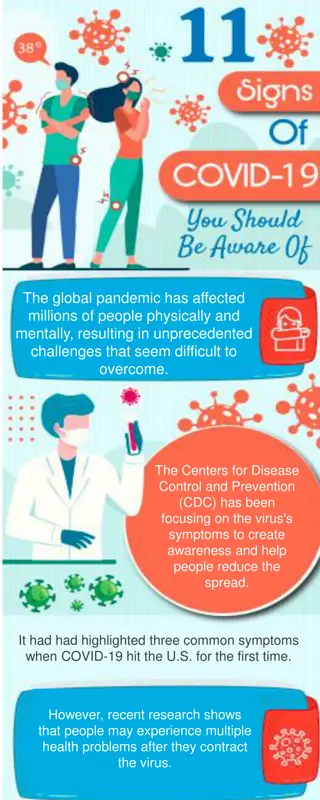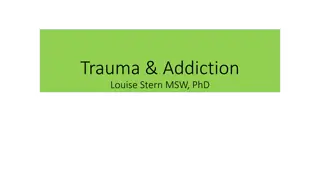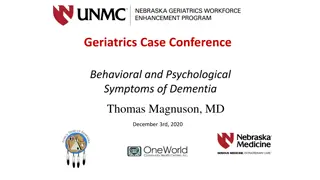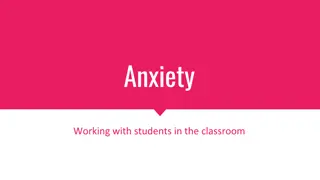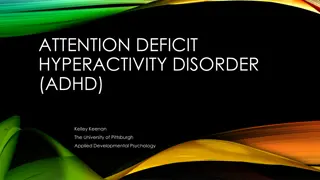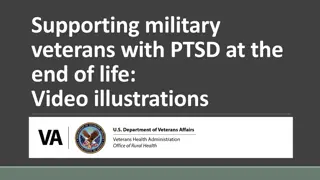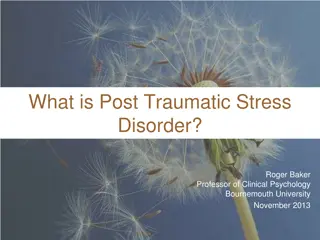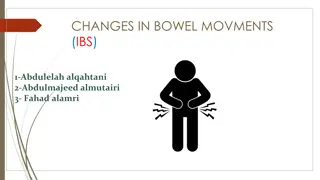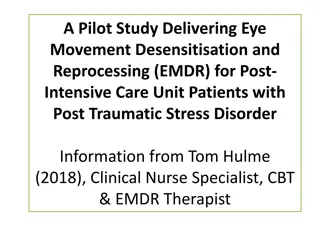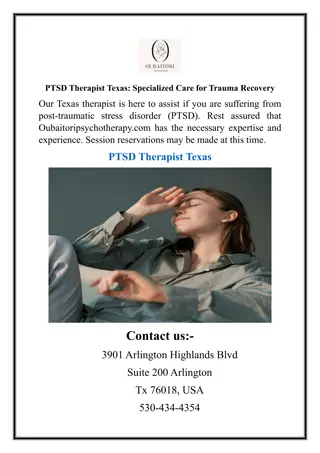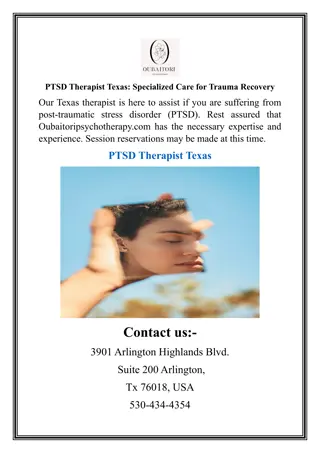First Responder Trauma: Understanding Stress Effects
Explore the impact of stress on body and mind, from acute to chronic stress types, including critical incident stress and PTSD. Learn to recognize and manage stress for mental and physical well-being.
0 views • 27 slides
Addressing Functional Somatic Disorders in Patient Safety Rounds
Explore the burden of functional somatic symptoms in NS Health, delve into emotional factors contributing to somatic symptoms, and learn about evidence-based short-term talking therapy for functional somatic disorders. Gain insights from reference materials and data on unexplained symptoms and emerg
3 views • 29 slides
COMMON PSYCHOLOGICAL INJURIES &MANAGEMENT in WORKERS COMPENSATION
Discover insights on common psychological injuries, such as adjustment disorders, depression, and PTSD, prevalent in the workplace. Gain knowledge on identifying signs, symptoms, and providing crucial support as a case worker. Learn about good mental health, stress responses, and ways to manage psyc
3 views • 17 slides
Comprehensive School and Community Treatment Outcomes for Youth 2023 Legislative Update
The Comprehensive School and Community Treatment (CSCT) Program aims to support high-risk students behaviorally, socially, emotionally, and academically. The program provides individualized mental health services, enhances social and academic skills, and offers counseling to parents/families. CSCT t
0 views • 20 slides
PTSD Therapy Near Me - trinexpharmacy.com
Living with chronic pain can be challenging, and finding the right combination of medications to manage it can make a big difference in your quality of life. What Painkillers Can I Take With Pregabalin, commonly known by its brand name Lyrica, is a medication frequently prescribed for neuropathic pa
2 views • 6 slides
Understanding PTSD
If you or someone you know experiences symptoms of PTSD, consider reaching out to clinical supervision Melbourne health professional.
0 views • 5 slides
Understanding the 3 Ts of Trauma: Trajectory, Treatment, and Trust
This comprehensive guide delves into the critical aspects of trauma - Trajectory, Treatment, and Trust. It covers the definition of trauma, PTSD symptoms, potentially traumatic events, trajectories of traumatic stress, and the impact of trauma on mental health. Explore the effects on behavior, biolo
0 views • 29 slides
Understanding Anxiety Disorders in DSM-5
Anxiety disorders encompass a range of conditions, from separation anxiety to social phobia and generalized anxiety disorder. The DSM-5 has re-conceptualized these disorders, grouping OCD in its own category and moving PTSD to trauma-related disorders. Recognizing symptoms and seeking appropriate tr
1 views • 96 slides
Understanding Anxiety Disorders and Related Conditions
Explore the distinguishing features of anxiety disorders such as generalized anxiety disorder, panic disorder, and phobias, along with insights into obsessive-compulsive disorder (OCD) and posttraumatic stress disorder (PTSD). Delve into the impact of conditioning, cognition, and biology on these co
2 views • 46 slides
Overview of Anxiety and Related Disorders
Anxiety disorders, such as PTSD, panic disorders, phobias, agoraphobia, and OCD, are characterized by varying degrees of fear and distress. Anxiety is a normal response to danger, but when it becomes chronic, it can lead to debilitating conditions. PTSD occurs post-trauma, panic disorders involve in
1 views • 42 slides
Understanding Trauma and Stress-Related Disorders: A Comprehensive Overview
Trauma and stress-related disorders encompass maladaptive responses to severe stress, affecting social functioning. This article delves into classifications, specifically PTSD, emphasizing clinical presentation and management. It explores ICD-10 and ICD-11 coding, defining PTSD and its essential fea
0 views • 30 slides
Understanding PTSD and Trauma: A Comprehensive Overview
PTSD (Post-Traumatic Stress Disorder) is a clinical diagnosis that develops following exposure to a distressing event. Trauma describes something with a significant emotional impact. PTSD symptoms include re-experiencing, avoidance, hyperarousal, and emotional numbing. Complex PTSD (CPTSD) involves
0 views • 16 slides
Understanding Trauma Response and Treatment in the US
Trauma is prevalent in the US, with unresolved reactions affecting development and relationships. Effective treatment like Cognitive Processing Therapy (CPT) is vital for well-being. Sources of trauma include threats to the body, environmental events, and relational trauma. Responses to trauma vary
0 views • 18 slides
Understanding Sex Differences in Mental Illness and Its Impact
Exploring various aspects of mental health issues, this content sheds light on sex differences in depression, anxiety disorders, PTSD, and suicide rates. It discusses the age of onset for depression, the prevalence of anxiety disorders, and the challenges individuals face in dealing with mental illn
2 views • 10 slides
Understanding Traumatic Grief and Bereavement: A Comprehensive Overview
Explore the complexities of traumatic grief, bereavement, and loss through a detailed examination of definitions, theories, stages, symptoms, impact, and risk factors. Unpack the nuances of acute grief, integrated grief, and the coping mechanisms individuals utilize when faced with profound loss. Ga
1 views • 117 slides
Needle Blight Mycosphaerella Gibsonii: Symptoms, Host Plants, and Management
Needle blight caused by the fungal pathogen Mycosphaerella gibsonii is a serious disease affecting various species of Pinus trees. The disease, first recorded in Japan in 1913, primarily impacts seedlings and saplings, leading to significant infection rates and death rates under epidemic conditions.
0 views • 21 slides
Understanding Poliomyelitis: Causes, Symptoms, and Prevention
Poliomyelitis, commonly known as polio, is an infectious viral disease caused by the poliovirus. It primarily affects young children, leading to the destruction of motor neurons. The disease can manifest with varying symptoms, ranging from mild flu-like symptoms to severe paralysis. Poliovirus is tr
0 views • 12 slides
Understanding Moral Elevation in PTSD and Moral Injury
The research by Dr. Adam McGuire explores the role of moral elevation in PTSD and moral injury, emphasizing how witnessing virtuous behaviors triggers emotional and physical responses leading to a desire for imitating virtuous acts. By integrating prosocial emotions into trauma treatment, the positi
0 views • 13 slides
Understanding Psychotic Symptoms in Children and Youth
Psychotic symptoms in children and youth can manifest in various forms including hallucinations, grief-related apparitions, cultural influences, hypnagogic experiences, and imaginary friends. It's important to differentiate between non-pathological experiences and clinical psychosis. Psychotic sympt
0 views • 15 slides
Understanding Plant Diseases: Symptoms and Identification
Plant diseases induce reactions in host plants, leading to visible abnormalities known as symptoms. Common symptoms include mildew, rusts, smuts, white blisters, and blotches. Each type of disease manifests differently, such as powdery growth in mildew and pustules in rusts. Proper identification of
0 views • 171 slides
Understanding Peptic Ulcers: Causes, Symptoms, and Treatment
Peptic ulcers are open sores that form in the stomach or upper small intestine, leading to symptoms like stomach pain, bloating, and nausea. Common causes include H. pylori infection and NSAID use. Recognizing symptoms, such as burning stomach pain, is crucial for timely diagnosis and management. Se
0 views • 19 slides
Managing Menopausal Symptoms After Breast Cancer: Key Considerations
Menopausal symptoms can significantly impact the quality of life for breast cancer survivors, affecting their tolerance of treatments and overall well-being. Understanding the causes and management strategies for these symptoms is crucial to support these individuals through their post-cancer journe
0 views • 28 slides
Understanding Asthma: Symptoms, Triggers, and Management in Schools
Asthma is a common condition affecting many individuals, especially in school settings. This training aims to educate on recognizing asthma, providing support during attacks, available treatments, and school responsibilities. Asthma symptoms include coughing, wheezing, chest tightness, and shortness
0 views • 14 slides
Understanding Anaphylaxis: Symptoms, Signs, and Treatment
Anaphylaxis is a severe, life-threatening allergic reaction that can occur in response to various allergens. It manifests rapidly with symptoms like difficulty breathing, abdominal pain, skin reactions, and more. Early recognition of symptoms and prompt treatment with adrenaline are crucial for mana
0 views • 23 slides
The Role of French National Agency of Public Health in Responding to Terrorist Attacks
French National Agency of Public Health, Santé Publique France, plays a crucial role in responding to terrorist attacks by mobilizing emergency response, syndromic surveillance, and preventing post-traumatic stress disorders (PTSD) among the affected population. They manage the French health reserv
0 views • 11 slides
Understanding Schizophrenia: Symptoms and Definitions
Schizophrenia is a complex mental disorder characterized by delusions, hallucinations, disorganized speech, and negative symptoms. It involves a significant decline in functioning and must persist for at least 6 months. Common terms associated with schizophrenia include catatonia, paranoia, associat
0 views • 10 slides
Understanding Psychopathology: Symptoms and Signs in Psychiatry
Psychopathology involves the study of symptoms and signs in psychiatry, where signs are objective observations and symptoms are subjective experiences. Mental disorders encompass a range of issues affecting thoughts, emotions, behaviors, and relationships. Recognizing signs and symptoms such as slee
0 views • 31 slides
Understanding COVID-19 Symptoms and Differentiating from Other Illnesses
The global pandemic has brought about unprecedented challenges, with researchers updating the list of symptoms associated with COVID-19 infection. Common symptoms include fever, cough, shortness of breath, sore throat, congestion, loss of taste and smell, headache, fatigue, muscle pain, diarrhea, na
0 views • 5 slides
Understanding Trauma, Addiction, and Their Interconnection
Experiencing trauma does not guarantee addiction, but research links trauma to addictive behaviors. Trauma, whether single, complex, or historical, can lead to substance use as a coping mechanism. Psychological trauma like ACEs, childhood maltreatment, and PTSD are significant factors. Co-morbidity
0 views • 12 slides
Understanding Behavioral Symptoms of Dementia in Geriatric Patients
This informational content discusses the various behavioral and psychological symptoms of dementia (BPSD) in geriatric patients, including common symptoms like depression, aggression, anxiety, and apathy. It highlights the prevalence of behavioral issues in dementia patients, their impact on caregiv
0 views • 15 slides
Understanding Anxiety in Students: Impacts and Disorders
Anxiety in students can manifest as excessive worry, stress, and physical symptoms that interfere with daily life. Generalized anxiety, social anxiety, panic disorders, and PTSD are among the various forms of anxiety disorders that may affect students in the classroom. Recognizing and addressing the
0 views • 13 slides
Understanding ADHD: Symptoms and Classroom Strategies
This comprehensive guide explores ADHD, its symptoms of inattention and hyperactivity/impulsivity, diagnostic criteria, and classroom strategies for children affected by ADHD. The seminar objectives include defining ADHD, identifying symptoms, evaluating classroom practices, and developing ADHD-awar
0 views • 19 slides
Understanding Vaginal Symptoms in Menopause and Barriers to Treatment
The article discusses the various symptoms associated with the Genitourinary Syndrome of Menopause (GSM) such as decreased vaginal moisture, urinary frequency, and sexual difficulties. It highlights the prevalence of these symptoms in women and the barriers to seeking treatment, including discomfort
1 views • 7 slides
Supporting Military Veterans with PTSD at End of Life: Insights and Video Illustrations
Video illustrations and insights from hospice and palliative care clinicians, focusing on supporting military veterans with PTSD at the end of life. The team of professionals provides tips and personal insights, along with three videos showcasing veterans discussing trauma and compassionate care. Vi
0 views • 21 slides
Understanding Post-Traumatic Stress Disorder (PTSD) and Trauma
Post-Traumatic Stress Disorder (PTSD) is a psychological condition that may develop after a person experiences a traumatic event. Trauma can result from various incidents such as accidents, natural disasters, abuse, or war, leading to personal reactions and challenges in one's perceptions. Victims o
0 views • 104 slides
Understanding Irritable Bowel Syndrome: Symptoms, Diagnosis, and Management
Define constipation and diarrhea, discuss the definition, etiology, and classification of IBS, explain how to diagnose IBS, list alarm symptoms and differential diagnosis, provide a management plan and follow-up, and recognize when to refer to a specialist. People with irritable bowel syndrome may s
0 views • 35 slides
Delivering EMDR for PTSD in Post-ICU Patients: A Pilot Study by Tom Hulme
More ICU survivors are experiencing PTSD post-discharge. Symptoms include intrusive thoughts, nightmares, avoidant behavior, and hypervigilance. EMDR therapy is recognized as effective. This pilot study aims to provide evidence-based treatment to improve health outcomes in this patient group.
0 views • 10 slides
Best PTSD in Maywood
If you\u2019re looking for PTSD in Maywood, contact Saggu Counselling. They have worked extensively with individuals from various backgrounds and am proud to offer an inclusive, open-minded, non-judgmental space where you can feel safe, supported and
0 views • 6 slides
PTSD Therapist Texas Specialized Care for Trauma Recovery
Our Texas therapist is here to assist if you are suffering from post-traumatic stress disorder (PTSD). Rest assured that Oubaitoripsychotherapy.com has the necessary expertise and experience. Session reservations may be made at this time.\n\n\/\/ \/
2 views • 1 slides
PTSD Therapist Texas Specialized Care for Trauma Recovery
Our Texas therapist is here to assist if you are suffering from post-traumatic stress disorder (PTSD). Rest assured that Oubaitoripsychotherapy.com has the necessary expertise and experience. Session reservations may be made at this time.\n\n\/\/ \/
3 views • 1 slides
